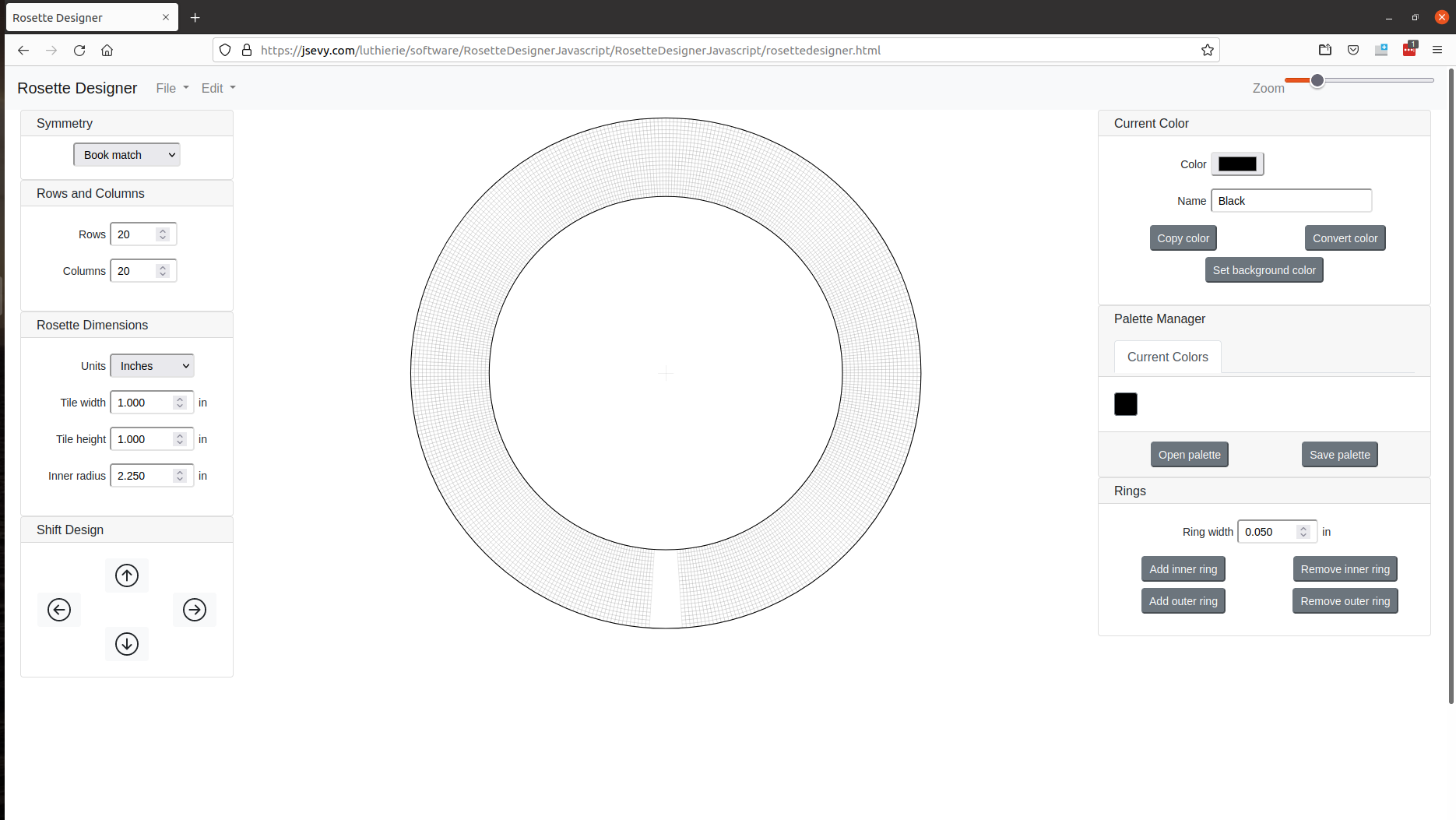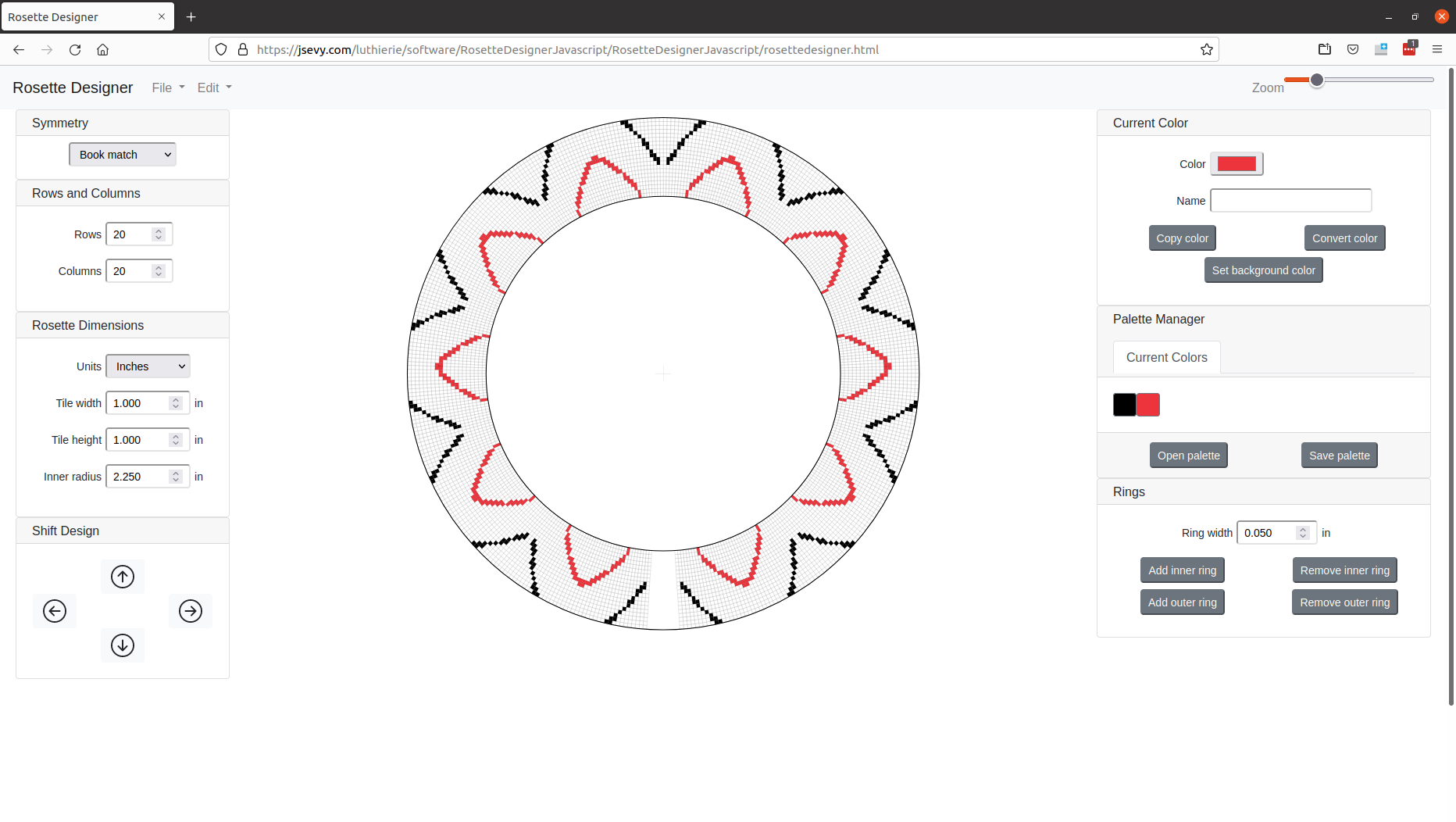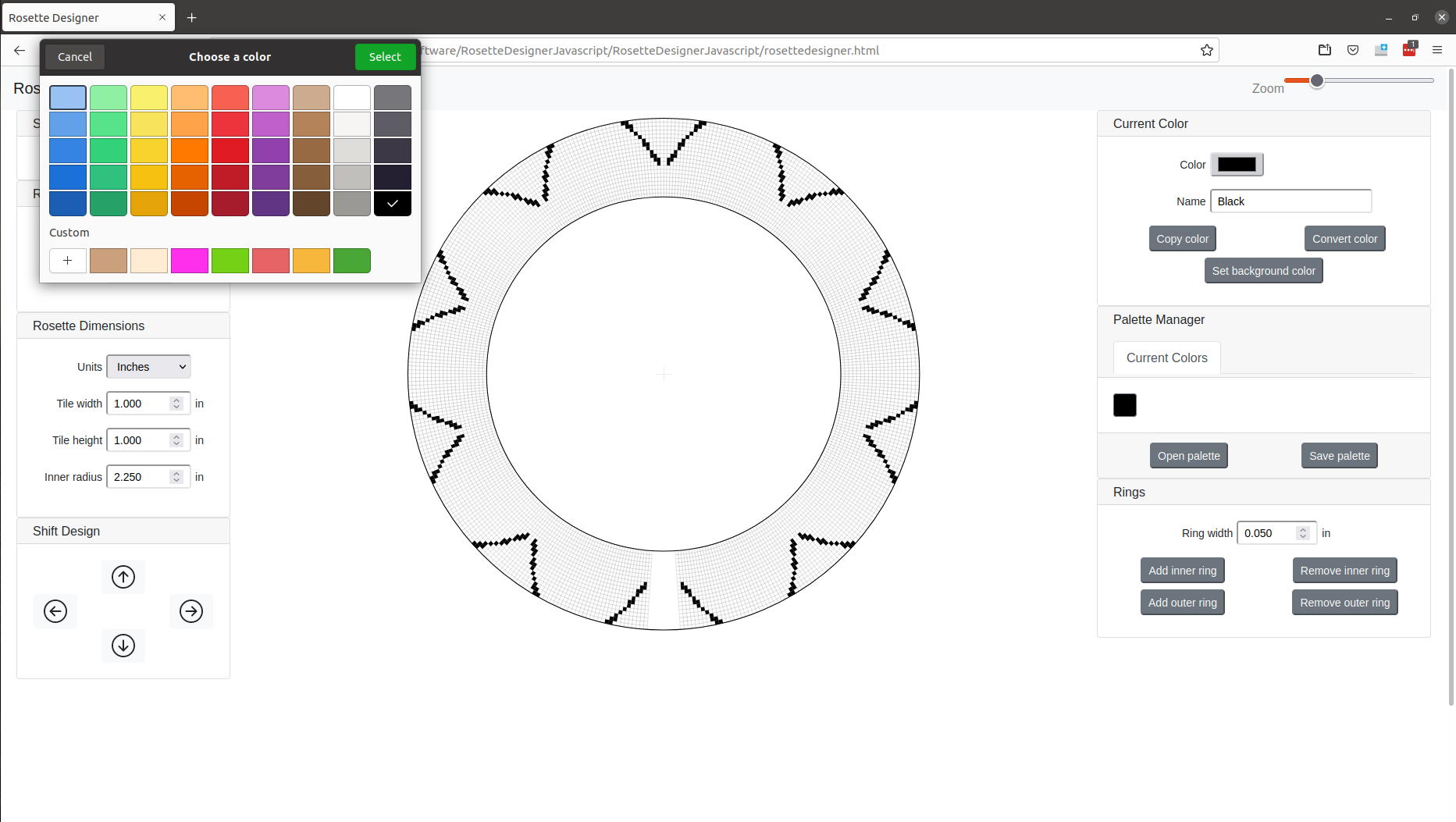Startup
To start the app, just open the web link in a web browser. A blank design is shown with the default rosette parameters (20 rows and 20 columns). The rosette is shown in the middle, with various controls in the left and right columns and a navigation bar at the top.
Drawing
Simply click and drag the mouse across the mosaic elements in the rosette design; the tile elements below the cursor’s path will be colored in the corresponding color, and the design will be filled out in a repeating pattern around the rosette.
Erasing
To erase, just start on one of the tile elements which already has the current color; it will be erased back to the background color, as will any of the other elements as you drag the cursor across them.
Left-Hand Controls
The controls on the left provide functions for working with the design.
Symmetry
The symmetry buttons determine how the fundamental tile will be replicated to fill out the rosette. The slip match stetting just translates the fundamental tile to the left and right. The book match setting reflects the fundamental tile across a vertical line as in the opening of a book. The inversion setting flips the fundamental tile across a horizontal line while repeating, and the book inversion combines the book match and inversion settings, flipping across both horizontal and vertical.
Rows and Columns
The row and column settings let you choose the number of rows and columns in the fundamental tile. The size (height and width) of the fundamental tile, or each row and column, can be set in the Rosette Parameters dialog box accessible through the main menu. The radio buttons indicate whether the tile width/height or the row and column widths should be kept constant as the number of rows and columns are adjusted.
Rosette Dimensions
Allows you to specify the units used (inches/cm), the inner radius of the rosette, and the width and height of the fundamental tile.
Shifts
The shift buttons allow the design to be shifted up, down, left or right. The left and right shifts are useful for aligning the design in the “fundamental tile” outlined in black on the tile strip. The up and down shifts are useful particularly when you decide to add rows to provide borders on the top and bottom.
Right-Hand Controls
The controls on the right provide functions for working with colors and adding inner and outer rings to the design.
Current Color
The current drawing color can be selected by clicking on the colored square; this will bring up a color selector.(The color can also be chosen from available palettes of colors; these are discussed below.) Note that colors can be given names in the provided text box. This can make them easier to identify when the design is exported as a PDF.
Note that the exact mechanism for specifying the new color varies from system to system, i.e., the color-selection dialog bozes differ. However, one feature that is usually present is the ability to select a color from an image (jpg, png, etc.) in another web browser tab. This is particularly useful for creating colors from images of the woods to be used in a rosette. These “natural” colors can then be saved as a palette (discussed below) for use in future designs.
Copy Color
This allows you to copy a color already in the design – just click the button and select a color from the rosette. This will become the current drawing color
Convert Color
The “Convert color” button allows for the replacement of all pixels of a selected color with the current color. To convert, set the desired new color as the current color, click the “Convert color” button, and then use the mouse to select a pixel in the design with the color you wish to convert. All of the pixels in the design which have that selected color will be converted to the current color.
Set Background Color
The background color for the design can be changed using the “Set background” button. All of the pixels in the background color will be set to the current color. Note that the effect of this is slightly different than using the “Convert color” button and choosing one of the background pixels. The background color is used when erasing pixels; if you simply convert the background pixels to a new color with the “Convert color” button, the default background color (white) will still be used when pixels in the design are erased.
Palette Manager
The Palette Manager provides a means to select colors from “palettes” of recently used or saved colors. The “Current colors” palette is always present, and keeps a list of the colors that have been used so far in the design. To select a color, just click on one of the colored buttons. The “Save palette” button allows you to save a palette of colors for use in future designs; the “Open palette” button allows you to open a palette that has previously been saved. This is particularly useful for saving colors of woods frequently used in rosettes.
The “Get color from image” tab allows you to select a saved image in a standard format (jpg, png, etc.) and then select a color from one of the pixels in the image. This is particularly useful for creating colors from images of the woods to be used in a rosette. A sample palette that has done this for some commonly used woods is provided in the sample palette file “Wood palette.xml”.
Rings
The Rings panel allows inner and outer rings to be added to (and removed from) the design. This reflects the common practice of adding such rings as strips of wood on the inner and outer edges of the rosette. The thickness of each ring can be specified, and the color of an added ring is whatever the current drawing color is.
Menu Bar
File Menu
Open
Prompts to select a file to open that contains a rosette design, prompting you first to save the current design if needed. If a file is selected that doesn’t contain a valid design description, an error message will be displayed.
Save
Save the design to a file. You can choose any location and name that you like. Note that the file generated contains an XML description of the rosette design, which is a hierarchical text description. You can view the generated XML in any text viewer, and even edit it directly if you like (but you’ll need to know what you’re doing, or you could end up with an invalid description that Rosette Designer won’t be able to read).
Export as PDF
Save the design in the standard Portable Document Format for printing or viewing in any PDF file viewer (Acroread, e.g.). This includes an image of the rosette, an expanded map of the fundamental tile showing clearly which element color is in each row and column, the counts of the number of tiles of each color used in the design, and dimensions of the rows and columns. This information is especially useful to a luthier in constructing a rosette from the design.
Export as PNG
Save the design as a PNG image. This saves an image of just the circular rosette design, with transparent pixels for the center of the design for easy pasting as an overlay on another image (e.g., a guitar design).
New
Erase the current design, prompting to save if there have been changes.
Edit Menu
Undo, Redo
These allow operations (drawing, row/column changes, color conversion, etc.) to be undone or redone. Note that there’s a maximum number of steps that can be undone (currently 50).
Zoom
A slider allowing the design to be zoomed in or out.


